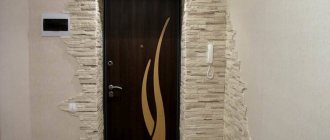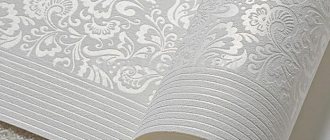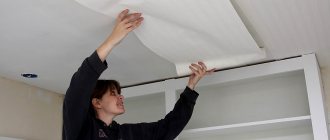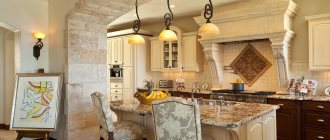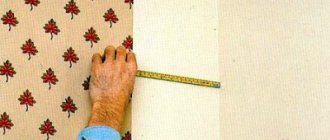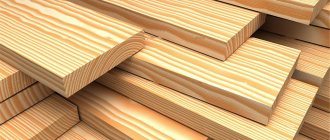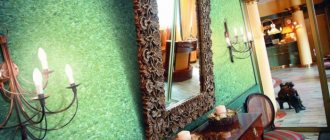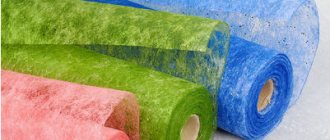Speaking about how to glue vinyl wallpaper, it is important to note that they can only be glued end-to-end, because the material has a high-density structure and relief. When applying the adhesive composition, it is necessary to carefully process the edges of the canvases so that after gluing they do not peel off or come apart.
Before gluing vinyl wallpaper, you need to decide on the choice of glue. You need a specialized glue that is designed for gluing such canvases. For example, if you use regular wallpaper glue, then during gluing the canvases will be stretched, and after drying they will simply shrink, resulting in unsightly joints between them.
For this type of wallpaper, a special glue is sold that holds the vinyl strips well, does not allow them to shrink, and does not allow them to change in size after drying.
Important! You need to apply glue to the wallpaper and the wall (although it is often limited to applying it to canvas). You cannot glue canvases if only the wall is treated with glue. If the surface is primed with glue, there is no need to treat it - just apply the glue to the vinyl sheets.
Specifications
Paper-based vinyl wallpaper consists of two components: paper and polyvinyl chloride. Paper is a universal material that has sufficient density to form a stable base. At the same time, it perfectly allows air to pass through and does not accumulate moisture.
Polyvinyl chloride increases the value of each cellulose characteristic several times. Thanks to the chemical component, the wallpaper becomes more resistant to mechanical stress and sunlight. This type of finishing material refers to heavy wallpaper that requires a special gluing technique.
Manufacturing principle
The properties and characteristics of the material are determined by the peculiarities of production. The technology is considered unique and guarantees the quality of the product. The principle of manufacturing vinyl wallpaper consists of the following features:
- The prepared cellulose is placed on a special machine where vinyl will be applied.
- Using a special printer, vinyl is applied to the surface of the paper. The procedure is repeated several times to form several layers.
- Decorative paint with mirroring and shine effects is sometimes applied over the main vinyl pattern.
- At the end, the canvas is covered with a thin layer of wallpaper varnish. The product protects vinyl from fading and deformation.
- When the varnish has dried, the wallpaper is sent for surface treatment with special means.
Paper coating and processing agents have specific characteristics that allow the surface of the material to be wiped with a damp sponge. Wallpaper with increased durability can even be washed.
Variety of material presented
Paper-based vinyl wallpaper can be divided into several types, each of which has special advantages and disadvantages.
The most popular types:
- Foamed vinyl. It is characterized by low resistance to mechanical stress, but allows air to pass through well. Such wallpaper is easy to glue.
- Silkscreen printing. Vinyl is applied using a special machine that imprints the design on the base under high temperature. They imitate expensive textile wallpapers, but are more affordable compared to them.
- Smooth vinyl. Thanks to the stability and method of applying the main component, the finished canvas can imitate any building material. Used in rooms with a special functional focus.
- Hard vinyl. Used in finishing when it is necessary to imitate leather, plaster, suede, textiles. It is highly resistant to any impact.
Each type differs in price and functionality. The choice of one of them is determined by the conditions of further operation of the room.
Advantages of vinyl wallpaper
Advantages of paper-based vinyl wallpaper:
- Aesthetically attractive appearance.
- Variety of reliefs and colors.
- They are able to imitate any artificial and natural material.
- Improves sound insulation.
- Hides defects and uneven walls.
- Affordable price.
- Can be used in almost any room.
- High moisture resistance, ability to withstand large mechanical impacts.
- The fabric has high density and elasticity.
- They practically do not fade and do not lose their attractiveness over time.
The advantages of this finishing material for walls make it very popular among designers.
Obvious shortcomings of the finishing material
The presented material has its shortcomings, which are easily compensated for by its attractive appearance.
Paper-based vinyl wallpaper has the following disadvantages:
- The environmental friendliness of vinyl wallpaper on cellulose fabric is considered quite low in comparison with analogues.
- Low air permeability of walls and the material itself.
- Problematic installation of this type of wallpaper.
- For gluing, it is advisable to seek the help of professionals.
- The unpleasant odor persists for some time.
When choosing such a wall covering, it is worth taking into account unfavorable factors. Especially if the renovation is carried out in a children's room, bedroom, recreation or sleeping area.
Which glue to choose
On the building materials market in Russia there is a huge selection of adhesives for each type of base (paper or non-woven fabric) and the weight of vinyl wallpaper (light or heavy). But there is one nuance here. An attentive buyer may notice that the adhesive for lightweight paper-based vinyl wallpaper does not differ from the composition for the same lightweight non-woven-based trellises.
In both cases, modified starch is mixed with methylcellulose. The composition also contains additives against mold and mildew. The only difference is the absence of a special additive in the glue for the non-woven base, which ensures good sliding of the trellis sheets along the wall.
Professional finishers claim that the presence or absence of such additives is practically unnoticed. The only difference: glue for a non-woven base when used under paper should be more liquid than stated in the instructions, and vice versa.
Important: it is strictly forbidden to use types of glue for light wallpaper on heavy vinyl - the more liquid structure of the composition does not hold the massive fabric of the trellis. Even if you dilute the adhesive composition to a jelly state, there will be no positive result.
Determining the number of packs is not difficult. The packaging indicates the number of tubes that can be glued with the diluted compound, but with a slight spread. For example, on a pack of Kleo there are numbers 7-9 rolls. It is necessary to take the average value. After this, the number of rolls required for pasting the walls is divided by the average figure and the number of packs of glue required for repair work is obtained.
It is advisable to purchase glue based on modified starch with minor additions of methylcellulose. It has good adhesive properties and a more affordable price compared to other types of glue.
However, there is an exception - Moment , produced in Russia by the German concern Henkel. In its composition, starch is added to methylcellulose, which makes it possible to increase the adhesive properties of the glue while maintaining the price at the level of starch products. Packaged in packs of 250 g (for an average of 5 rolls) and 500 g (for 10 tubes). Does not smell and does not leave marks after drying. When diluted, in a tightly closed container (can be wrapped in plastic cling film) it can be stored for up to 10 days. There is one drawback, but a relative one - it takes a long time to swell.
Among other brands of glue, consumers highlight “Kleo Smart”, “Metylan Vinyl”, “Axton Vinyl”, etc. More details about these and other brands of vinyl glue can be found in the work “How to choose wallpaper glue?”.
Value for money
The average cost is determined in accordance with the quality and type of material. Due to manufacturing techniques, the price may differ qualitatively from that of other finishing materials of a similar type.
Average price of paper-based vinyl wallpaper:
- The simplest wallpaper of this type costs between 150 and 900 rubles per roll.
- Foamed vinyl will be more expensive - the price varies from 300 to 500 rubles per unit of goods.
- Silk-screen printing costs from 700 to 1500 rubles per roll.
- Smooth and hard vinyl can cost between 1,500 and 3,500 rubles per unit.
The price of envy largely depends on the manufacturer. Branded finishing materials may be of worse quality, but more expensive than an unadvertised analogue.
Vinyl wallpapering
The process of gluing vinyl sheets also includes several steps that must be performed sequentially. Pasting is a simple process that can be done by two people.
The main thing is to purchase a high-quality and suitable adhesive composition, and also follow the basic recommendations.
Mixing glue
Vinyl wallpaper adhesive needs some time for the mixture to infuse, so mixing the adhesive composition is the first step. The adhesive mixture must be prepared strictly according to the instructions on the packaging (in each case it will be unique depending on the manufacturer).
Adhesive for vinyl sheets usually needs to be poured into a container with the required amount of water prepared in advance. Filling of dry adhesive powder is carried out gradually with constant stirring of the resulting mixture.
Preparation of canvases
Vinyl wallpaper can be with a clear pattern, which will require a high-quality fit, or without it. In the first case, the consumption of canvas will increase significantly.
There will be no waste if you need to glue vinyl photo wallpaper.
If the canvas has a pattern, you can customize it in several ways:
- It is necessary to mark the canvases in height, cut and paste the first strip, and then attach the next roll to it, moving it gradually to align the pattern. In this case, the waste will increase significantly (approximately 30-50 cm in length from each roll).
- If the second method is chosen, then you need to take into account the established pitch of the design elements and select the desired value of the shift between the canvases during the alignment process. This is a more complex but economical option.
- The third method involves using several rolls at the same time to adjust the pattern. For example, odd-numbered webs are taken from one roll, and even-numbered ones from the other.
Important! If it is possible and there is vinyl wallpaper in stock, then it is recommended to choose the consumable first method, because it is easier to perform and more familiar.
Wallpaper cutting
When cutting the roll, you need to take into account the height of the surface to be pasted, the step of displacement of the pattern and make a reserve of length for the final trim. A margin of 5-7 cm is quite enough. In the marked place, you need to bend the wallpaper, smooth the fold, cut it with scissors or a sharp knife.
It is recommended to cut strips from 2-3 rolls at once, so that each time after gluing the strip you do not have to cut it again.
Important! It is immediately recommended to number the cut strips (in accordance with the selected pattern) to avoid confusion.
Gluing process
Wall covering with vinyl wallpaper is carried out sequentially. There is a certain scheme in accordance with which such work is carried out.
It is better to glue vinyl wallpaper together.
The work is carried out in the following sequence:
- At the first stage, the prepared adhesive composition is applied to the wallpaper strip and to the wall. Wallpaper glue should be applied to the wallpaper using a roller, brush or regular sponge. Particular attention should be paid to the edges of the stripes.
2. The strip of vinyl wallpaper must be glued from above, placing the upper edge of the canvas against the pre-glued cornice with a slight overlap. In the vertical plane, it is strongly recommended to level the glued strip using a level.
3. After gluing the top part of the strip, you need to gradually, moving towards the bottom, press it against the wall using a plastic spatula or roller. It is best to straighten the strip using the herringbone method, i.e. removing air by moving the spatula from the center to the edges of the strip. It is recommended to immediately remove the glue squeezed out of the vinyl sheet with a clean rag or sponge.
4. Gluing the second strip is done in the same way, but now you need to glue it so that the pattern matches. First you need to align the canvas strictly along the joint line, after which you can begin to combine the pattern.
5. For the corner parts of the room, you need to use strips that should extend onto the adjacent wall by about 3-4 cm.
After the vinyl wallpaper has been glued, it is recommended to remove all remaining building materials, tools, and containers with adhesive from the room.
The door and windows in the room should be closed to speed up the drying process; do not turn on the fan or air conditioner.
After gluing, you need to wait at least 1-2 days for the adhesive mixture to harden. If immediately after gluing you open the window and create a draft in the room, then there is a high probability that the vinyl wallpaper will simply peel off.
Vinyl wallpaper: selection, gluing and tips (2 videos)
Pasting vinyl wallpaper (25 photos)
Required tools and materials
Before gluing vinyl wallpaper on a paper base, you should prepare the necessary tools and materials:
- Several paint brushes of different widths.
- Wide bucket for diluting wallpaper glue.
- A stick or spatula for mixing the glue.
- To measure the canvas, you need a pencil, measuring tape and a stationery knife.
- Adhesive for paper-based vinyl wallpaper should be quick-drying.
To prepare the canvases before gluing, you need to select the appropriate surface. It should be smooth, clean, without patterns.
What tools are needed?
To complete the work you will need to use the following tools:
- Wide brush, soft roller.
- Square, pencil.
- Rubberized roller.
- Plastic spatula.
- Clean rag, sponge.
- Stationery knife.
- Level, ruler, plumb line.
- Wide metal spatula.
- Construction tape.
Important! In order for vinyl sheets to last a long time and not come off after gluing, the rough surface must first be prepared for the gluing process.
Preparatory stage
First you need to prepare the wall surface. It should not contain remnants of old wallpaper or deep potholes. It is advisable to prime the walls under the wallpaper and then treat them with an antifungal solution.
You need to properly prepare the wallpaper itself before gluing:
- Cut the roll into strips of appropriate length.
- Place all the strips on top of each other, pattern down.
- When cutting, you should take into account the coincidence of the patterns on the strips and leave 10 centimeters of extra length.
- Apply glue to the strip and leave the canvas to swell for a while.
The swelling time and method of diluting the glue are indicated individually for each type of vinyl wallpaper.
Drying wallpaper with paper backing
How quickly this type of wallpaper dries depends on many factors. First of all, a significant point is the well-dried, prepared surface of the walls. If it was not dry, then the drying time of the wallpaper will be increased several times.
The best option is if the room temperature is approximately 20 degrees and the humidity is no more than 70%. If the temperature is lower and the humidity is high, then you will have to wait quite a long time for the walls to dry. In addition, this can lead to peeling and deformation of the canvas.
Important! It is possible to ventilate and carry out further finishing work only after the coating has completely dried.
Rules for gluing
Before gluing vinyl wallpaper on a paper base, you need to familiarize yourself with the operating rules. The features of this material require a special approach to the gluing process. It is worth considering that when the canvas is lubricated, the paper fibers swell. After drying, on the contrary, they shrink. Therefore, beginners often have problems with seams coming apart after gluing walls.
There should be no drafts in the room where repairs are being made. The temperature regime must be maintained until the glue dries.
How to properly glue vinyl wallpaper on paper:
- Apply glue to the strip and wait until the canvas swells.
- Pasting is done from the far corner of the room.
- Place the strip on the wall and smooth it using a smooth roller.
- Using a plastic trowel, remove the air from under the wallpaper. In this case, you need to move the trowel from the center of the strip to the edges.
- Any glue that appears on the front side of the strip must be wiped off immediately.
- The next strip must be applied end-to-end to the first. Overlapping gluing is prohibited. The further process is repeated as with the first strip.
Gaps between the strips after drying are formed if you overdo it with the time allotted for the canvas to swell. Other installation features are usually indicated in the instructions included with the roll. Basically, additional gluing conditions are indicated for special types of material.
How long does it take for vinyl wallpaper to dry?
The premises must remain closed throughout the day. A draft leads to overdrying. Forced heating is also undesirable, and the use of air heaters is prohibited. Within a day it will be possible to open windows and doors. But if it’s cold outside and the room is not heated, you’ll have to wait 2-3 days.
Having done everything as described above, anyone can hang vinyl wallpaper with their own hands and save money.
Dismantling finishing material
In the process of preparing walls for renovation, problems often arise with dismantling old cellulose-based vinyl wallpaper. To simplify this procedure, it is worth remembering a few simple rules.
First, it is necessary to determine the main characteristics that this type of material has. They are usually divided into two types: resistant to mechanical damage or moisture. Secondly, we choose the dismantling method, taking into account the weaknesses of the product.
How to remove paper-backed vinyl wallpaper without difficulty:
- First you need to damage the top layer of wallpaper using a spiked roller. The multilayer nature of the material will not allow it to touch the wall surface. You can replace the special roller with a brush with metal bristles. Using a spray bottle, moisten the working area with water. It is better to add a little shampoo or liquid soap to the liquid to quickly dissolve the wallpaper glue. When the paper is completely wet, you can remove pieces of material from the bottom up.
- First, perforate the top layer of the old coating, and then apply steam. For steaming, you can use a hair dryer, steam generator, iron with a wet cloth. Wallpaper glue swells when heated and easily comes off the wall surface. In this situation, the direction of removing wallpaper is from bottom to top.
- You can use the first method with some addition. In addition to the soap solution, add a little regular wallpaper glue to the liquid. The surface is moistened with a cloth and left for three hours. After swelling, the canvas is removed in solid strips from bottom to top.
- Vinyl wallpaper is removed from drywall in the same way as from a regular wall. First, perforation is performed, then wetting, and then cleaning. The only caveat is minimal wetting so as not to damage the drywall itself.
To avoid problems during the dismantling process, you should follow all the work rules when gluing: use special glue, pre-prime the surface of the walls.
Preparing the walls
This stage of work begins with cleaning the surface of the old coating. Before hanging vinyl wallpaper, all hooks, nails, and awnings are removed from the walls. It is necessary to remove decorative covers from sockets and switches. Skirting boards and door frames do not need to be removed, but simply cut along the line after the sticker.
Further technology for preparing walls for gluing vinyl wallpaper depends on the thickness of the purchased material. For light and thin trellises, mandatory puttying of the surface is required, if it has not been done previously, followed by grinding and treatment with deep penetration primer.
Pay attention to the vertical angles and their correspondence to 90°. Any irregularities make it very difficult to accurately fit the joints. All protrusions, holes and cracks will become noticeable over time.
Under wallpaper with a foam layer of vinyl and hard grades, it is enough to do a rough local leveling, which will eliminate the most noticeable defects. Textured trellises made using silk-screen printing technology also hide uneven walls well, especially if there is a contrasting pattern.
Glue selection
Manufacturers offer several types of wallpaper paste, each of which is designed for a specific type of trellis. But, having carefully studied the composition, you can see that all domestic products are made on the basis of modified starch, to which methylcellulose is added, as well as antifungal additives. Non-woven vinyl wallpaper adhesive may contain additives to improve glide over the wall surface.
Having opted for domestic brands of wallpaper glue, you can be sure that they are all the same in terms of their basic composition. But for a polymer base, the finished adhesive should be more liquid than indicated in the instructions, since some of the moisture will be absorbed by the wall material . Among the recommended brands that have good characteristics and are sold at affordable prices are:
- Kleo Smart;
- Moment;
- Metylan Vinyl;
- Axton Vinyl.
The difference between European products usually lies in the replacement of modified starch with a high-quality natural component. This slightly increases the adhesion of the material and the glue preparation time, but does not give off any odor and reduces consumption.
The process of preparing glue consists of soaking it, keeping it in water for a given time, thoroughly mixing and a second soak until the mixture is completely dissolved. The required time intervals and amount of water are specified in the instructions for using the glue. The standard consumption is also indicated on the packaging and is always 10-15% more than actually required.
Cutting cloths
The main difficulty when cutting rolls into separate sheets is the need to match the pattern at the joints of adjacent strips. In addition, the ceiling height in most apartments in multi-storey buildings is in the range of 2800-3100 mm.
Therefore, when purchasing material, pay attention to the length of the roll to minimize trimmings. Please note that some of the short pieces can be used to finish areas above windows and doors.
Cutting should be done only after finishing the preparation of the walls and immediately after soaking the glue. By the time you cut the paper, it will already have time to swell. Cover the floor with old but clean newspapers. This will allow you to avoid staining the floor covering with glue and check the fit of the pattern in advance.
The height of the ceiling may vary in the room, so height measurements (lengths of wallpaper strips) need to be taken several times and simply write down this data on the wall. Paper cutting is done with a sharp stationery knife using a metal ruler or a plaster rule.
Reviews from people
Vinyl wallpaper on paper has varied reviews. Some people encounter problems already in the process of gluing the walls. Others received poor results due to the seams between the strips coming apart after drying. Those who love everything natural and environmentally friendly have a negative attitude towards this type of finishing material.
If you follow the rules regarding care, installation and dismantling, then vinyl wallpaper will not cause any complaints. Many are satisfied with the design, relief, and appearance. Thanks to this variety, you can decorate almost any room.
Practical people rely on long-term use, because the material is characterized by high resistance to mechanical damage, exposure to sunlight and moisture resistance.
Designer recommendations
Depending on the functional features of the room, designers offer their own ways of decorating walls with paper-based vinyl wallpaper. Recently, a method of zoning space has been used, when almost every wall is finished with a different material.
The same applies to gluing paper-based vinyl wallpaper. This type of material is used to decorate niches in walls, form tapestries, and cover areas with high humidity.
In rooms where people spend most of their time or relax, designers recommend using a minimal amount of finishing material with vinyl coating. Vinyl prevents normal air circulation - this can negatively affect the health of apartment residents.
In the kitchen, bathroom and hallway you can use only vinyl wallpaper. They are used to create panels, columns, arches, and certain areas for relaxation and work. A variety of textures, textures and a rich palette of colors allow you to use wallpaper in the design of any interior.
Wall marking
Marking walls for gluing vinyl wallpaper is one of the most important working stages.
If it is ignored, then when gluing the vinyl sheets will begin to gradually shift, you will have to constantly mix and move them, which will lead to additional time costs and increased material consumption.
Standard living rooms have 4 walls and 4 corners. You can start gluing vinyl wallpaper from the wall with a window or from the corner that is closest to the window. If gluing is supposed to be done from a corner, then it is necessary to immediately measure the verticality of this corner. This is necessary so that the first strip of vinyl wallpaper lies perfectly flat.
To do this, you need to step back about 3-4 cm from the corner of the room in the direction of gluing. Then you need to take a plumb line with a painted cord and secure it at the top of the wall. If there is a partner, then he can hold the lace from above. The plumb line must be lowered down, drawing a strict vertical line. Then the lace must be pulled and released, due to which an even vertical line will remain on the working surface. In the future, it will be possible to join subsequent strips of vinyl wallpaper to it.
The second side of the first wallpaper strip will be driven into a corner with a slight approach to the adjacent wall. If the corner of the room does not have an ideal vertical, due to this approach, this drawback will be almost completely leveled out.

